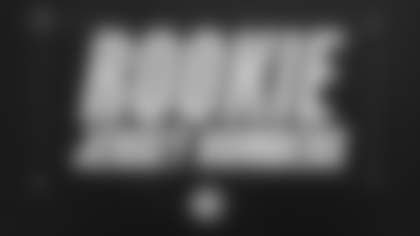Let's get to it:
GREG BELCHER FROM GILBERT, WV: If the Steelers draft a cornerback in the first round, would they feel pressure to start him over Steven Nelson if he performs well? And would they feel they made a bad free agent signing if that happened?
ANSWER: Based on the way the sport now is played at the professional level, a team that plans on contending for a championship knows it will need multiple playmaking cornerbacks to field a defense capable of helping the team to contend. As the Steelers roster currently is constituted, the only cornerback under contract I would label a sure thing is Joe Haden. In fact, I would argue the Steelers need to spend an early draft pick on a cornerback.
And beyond that, here is what General Manager Kevin Colbert said on Monday about having rookies play right away: "The people we draft, the longer we can keep them off the field, the better for them, historically. There have been some players, Maurkice Pouncey, as one example, was a first-year starter and became a great player. Ben (Roethlisberger) was forced to play (as a rookie) because Tommy Maddox got hurt, and obviously the results were great, but you really want to go in with these (draft picks) and delay them getting on the field as long as you can … because to have them have to step in and play, more often than not I think it is more detrimental to the player. And if he loses his confidence early, it's usually not returnable."
ROCK MORRIS FROM OXON HILL, MD: I'm part of a Steelers chat group on Facebook, and a lot of the people in that group are down on Mason Rudolph because he wasn't the No. 2 quarterback behind Ben Roethlisberger during his rookie year. How many quarterbacks did the Steelers have on the 2004 roster?
ANSWER: When training camp opened, the Steelers had four quarterbacks on their 90-man roster. In order: Tommy Maddox, Charlie Batch, rookie Ben Roethlisberger, and second-year pro Brian St. Pierre, who had been the team's fifth-round pick in 2003. Very shortly after camp opened, Batch sustained a knee injury that would land him on the injured reserve list, which in 2004 meant his season was over. Batch's injury also meant Roethlisberger became the No. 2 quarterback, and that move was made based primarily on his draft status (No. 1 pick, 11th overall) and raw skills. Over the course of that camp, Roethlisberger took advantage of the increased practice repetitions and clearly distanced himself from St. Pierre as the No. 2 quarterback on the depth chart. When Maddox was injured in the second game of the regular season – against the Ravens in Baltimore – Roethlisberger replaced him and finished that game and then started the next week in Miami. He played so well as the starter, and the team did so well with him as the starter, that even after Maddox was healthy Roethlisberger kept the job. St. Pierre served as the backup to Roethlisberger while Maddox was injured, and then he dropped to No. 3 on the depth chart after Maddox returned.
KEN MCDADE FROM WHITE PLAINS, MD: When trading up in the draft, are the teams allowed to discuss who they want to trade up for during the negotiations for the trade?
ANSWER: There are no rules prohibiting the kinds of discussions to which you refer. In fact, Bill Cowher told a story about the 2003 draft day trade in which the Steelers struck a deal with the Kansas City Chiefs to move up in the first round to select Troy Polamalu. Cowher, who had a good relationship with Chiefs President Carl Peterson after years of being an assistant on Coach Marty Schottenheimer's staff, was on the phone negotiating details of the trade. Cowher said that because the Chiefs were interested in picking Penn State running back Larry Johnson, Peterson asked him for assurances that the Steelers were not going to draft an offensive player should the trade be consummated. Cowher provided that assurance, the Chiefs closed the deal, the Steelers took Polamalu, and Kansas City ended up with Johnson.
ROBERT HICKMAN FROM LONDON, UNITED KINGDOM: If a team trades up in the draft, from No. 20 to No. 10, as an example, how is it sure it will get the player it's targeting, since the targeted player could be picked at No. 9?
ANSWER: The way it's done is the trade isn't finalized until the team with the No. 10 pick is on the clock. If the targeted player is still available, the trade is completed and the details are submitted to the NFL. If he's not, then no deal. That's why you don't see trades involving teams moving up in the draft – unless it's for the first overall pick – until the draft actually begins.
D.J. KEISLING FROM ENGLEWOOD, FL: Philadelphia needs a backup quarterback. Do they draft one, or do they look to see if the Steelers are interested in trading one of their backups? What value would Joshua Dobbs or Mason Rudolph hold as far as "draft capital?"
ANSWER: I have no way of knowing how the Eagles might choose to approach their perceived need for a backup quarterback, but I would highly doubt a team would offer anything but a late-round pick for either Joshua Dobbs or Mason Rudolph. Not that either of those guys have been disappointments to this stage of their professional development, but neither has shown much of anything yet in the NFL and teams value their draft choices. I also believe the Steelers like both of those young, up-and-coming players, both of whom are under contract at very reasonable salaries for the next couple of years at least.
DONNIE BROWN FROM VAN BUREN, ME: The Steelers finishing the season in Baltimore is surprising to me. Has that happened before? And just to be clear, I don't mean the Colts.
ANSWER: Since Art Modell's franchise left Cleveland and began play in Baltimore as the Ravens in 1996, there have been two occasions when the Steelers have ended a regular season there. The most recent time was in 2007 (a 27-21 loss), and the other occasion was in 2003 (a 13-10 loss in overtime).
An interesting sidebar to the 2003 game: Going into the final weekend of that regular season, the 6-9 Steelers had been eliminated from the playoffs, while the Ravens had clinched the AFC North Division title and were locked into a Wild Card Game against the Tennessee Titans. But Ravens Coach Brian Billick was so blinded by his hatred of the Steelers that he went all-out to win that game and in the process humiliate them by having Jamal Lewis break the NFL single-season rushing record against the Pittsburgh defense. Toward achieving those goals, Billick played his starters throughout most of a game that turned out to be a typical Steelers-Ravens bar brawl. The Ravens had to play overtime and Lewis still didn't break the record, but the loss they managed to inflict on the Steelers put Billick's hated rival into position in the next draft to be able to select a Miami (Ohio) quarterback named Ben Roethlisberger in the first round. On top of that, the bruised Ravens lost their playoff opener to the Titans.
RICHARD MEAGHER FROM LAKE HAVASU CITY, AZ: Should the Steelers pick a wide receiver in the first round? There are a few options who look very tempting and would help open up things for JuJu Smith-Schuster.
ANSWER: You must be late getting to this party. Defensive playmaker.
THOMAS DOWNS FROM NEW ROCHELLE, NY: Will the Steelers draft a wide receiver?
ANSWER: Yes, and my guess is that it will happen on Friday when Rounds 2-3 of the NFL Draft are conducted.
RICHARD FABER FROM JACKSON, MI: I would extend a trade proposal to Detroit where the Steelers would send their No. 20 overall pick plus a fifth-round choice to move up for the Lions' eighth overall pick in the first round. This would give us a great chance for a top defensive player. What would you propose?
ANSWER: There is no way, no way, no way, the Lions accept that trade proposal. No way.















